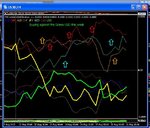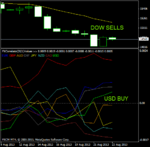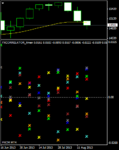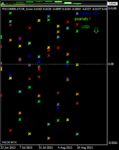Questions about correlation majors with Dow and Nasdaq
Hi Nvp, hi folk,
I would like to share some observations with you as well as some questioning.
Nvp, I have some questions for you (and if someone else has any inspiring answers, you are welcome...🙂).
I have been experimenting with FX corr strengh meter related to the the correlation of the main pairs with the Dow for some month now and tried to incorporate this system to my own system.
Basically, I am almost exclusively working on M1 Time Frame.
I have been observing some very interesting things, that I do not manage to understand at the moment, hence I am asking here to you Nvp, as well as to the others, what you think about all this.
I have been playing around with the MA settings 20, 80 and 200.
I have been observing the correlation between the Down and Nasdaq from one side with EURUSD, USDCHF, EURJPY, and USDJPY from the other side.
As we all know the triangle EURUSD, EURJPY and USDJPY has to be observed closely and as a whole to determine which pair will move the most and in which direction. Also, USDCHF is used to precise, confirm or sometimes give head up on EURUSD movements, sometimes in EURJPY.
(So I am now talking only about M1 time frame)
With all this in mind, I looked at how the Dow and Nasdaq moved compared to these pairs, when they cross the 80MA, the 200MA ad when do the bounce on it.
What I have been observing is that most of the time, the Dow or Nasdaq move before the currency pairs.
1) So here is my first question: how is it that the indexes move before the currency pairs? I am thinking that we need to purchase currencies (USD), to then be able to buy these index. It maybe be more logical on the sell side of the index: we get some cash when we sell them.
I will be glade if somebody could give me an explaination to that🙂.
Well that is not the core of my questioning.
I have been observing that most of the time the movments, I mean the legs of the swings and breakouts, happen just first on the indexes, and the currencies follow.
There is 3 differents possibilities:
a- positive correlation
b- negative correlation
c- no correlation.
I have been observing that for most of the time it is either a- or b-, either a clear positive correlation either a clear negative correlation.
So, for most of the time, the indexes moves, then at least one or two of these 4 pairs (EURUSD, USDCHF, EURJPY, and USDJPY) move and the correlation if either positive or negative.
Now what I really thought was incredible is the following exemple:
EURJPY start moving in the same direction as the indexes with a little lag. The indexes break down the 80MA. EURJPY follow with a little lag. then the indexes reach a low, start moving up again. EURJPY follow with a little lag. The indexes bounce on the 80MA and head south again. EURJPY follow with a little lag, also bounce on its 80MA and head south afterwards. Now the same pattern occurs again, new low for the indexes, they bounce again on the 80MA, and head south. But this time, EURJPY cross its 80MA up instead of bouncing down like the indexes. And from now on, the indexes and EURJPY are going to be perfectly negativly correlated for next 1h30. It means, when the indexes are going to make a new low, EURJPY is going to make a new high. When the indexes are going to bounce on the 80MA and head south again, EURJPY is going to bounce on its 80MA as well with a little lag and head north.
So here is what I have really not been able to determine:
2) What makes the correlation EURJPY (or any other of these 4 pairs)/Indexes (Dow and Nasdaq) shift from positive to negative in this way? I have been turning this in every way I have been thinking about with the strengh meter, but nothing really clear appeared (I have been following quite close what you are talking about Nvp, especially with the USD and Yen crossing together the 0 line).
Does anyone has an input on these to questions:
2) What makes the correlation EURJPY (or any other of these 4 pairs)/Indexes (Dow and Nasdaq) shift from positive to negative?
1) How is it that the indexes move before the currency pairs?
Thanks for reading, happy trading to all,
L








